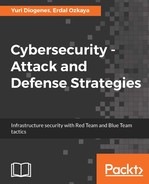The previous chapters have explained the process of performing an attack to a point where the attacker can compromise a system. The previous Chapter 7, Lateral Movement, discussed how an attacker can move around in the compromised system without being identified or raising any alarms. A general trend was observable, where legitimate tools were being used to avoid alerts. A similar trend may also be observed in this phase of the attack life cycle.
In this chapter, close attention will be paid to how attackers heighten the privileges of the user accounts that they have compromised. The aim of an attacker at this stage is to have the required level of privileges to achieve a greater objective. It could be mass deletion, corruption, or theft of data, disabling of computers, destroying hardware, and so many other things. An attacker requires control over access systems so that he can succeed with all of his plans. Mostly, attackers seek to acquire admin-level privileges before they start the actual attack. Many system developers have been employing the least privilege rule, where they assign users the least amount of privileges that are needed to perform their jobs. Therefore, most accounts do not have sufficient rights that can be abused to access or make changes to some files. Hackers will normally compromise these low-privileged accounts and, thus, have to upgrade them to higher privileges in order to access files or make changes to a system.
This chapter will cover the following topics:
- Infiltration
- Avoiding alerts
- Performing privilege escalation
- Conclusion
